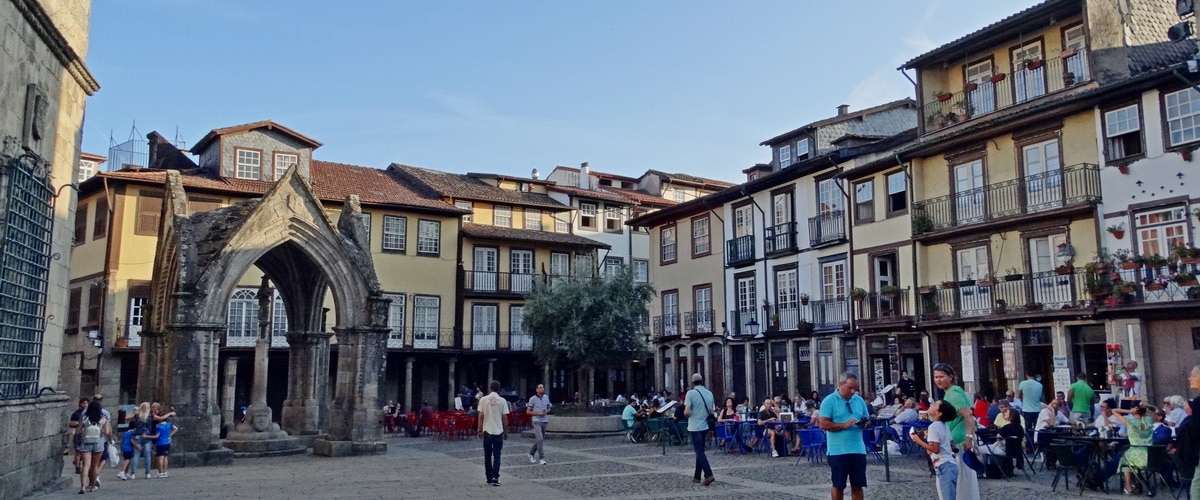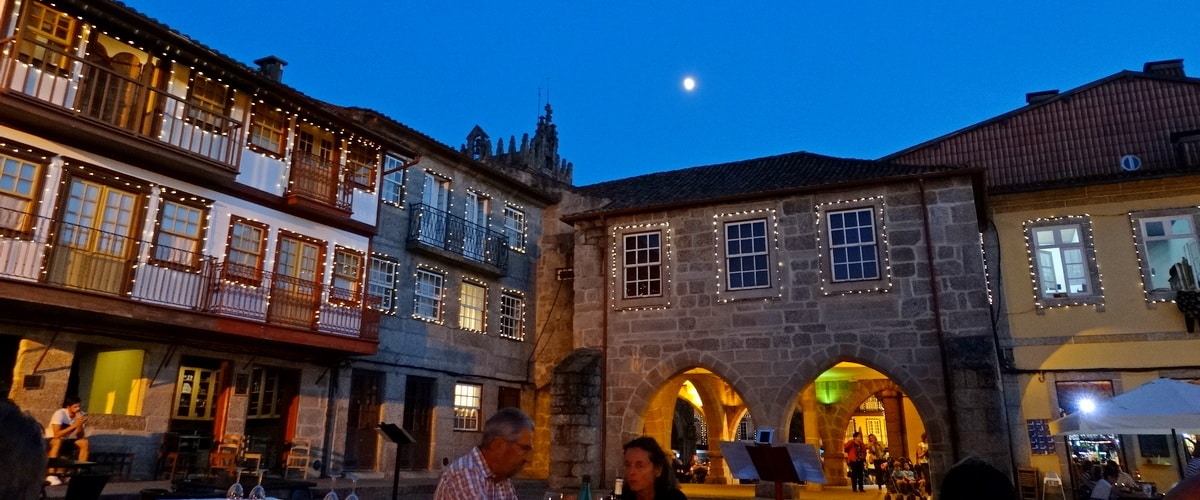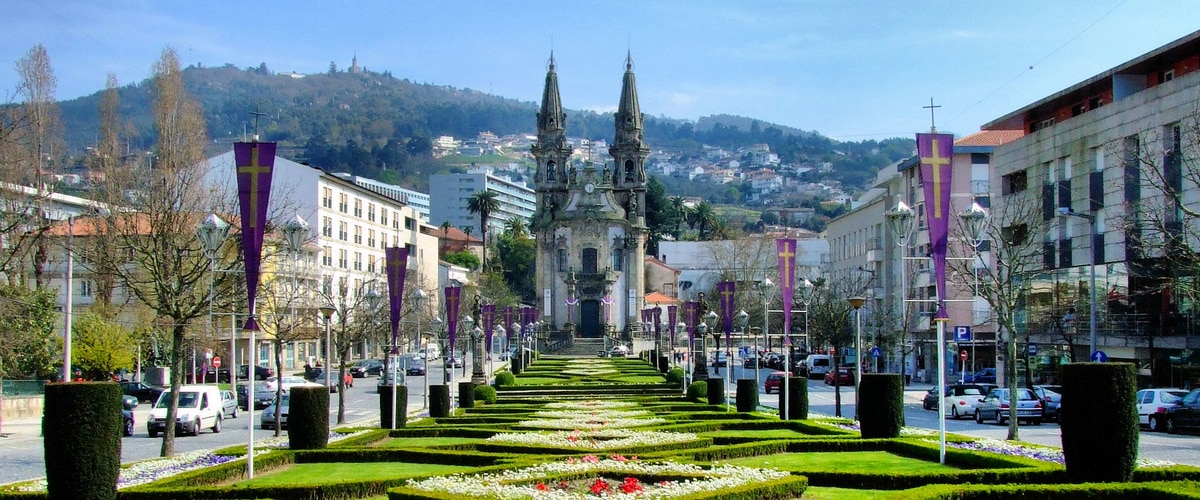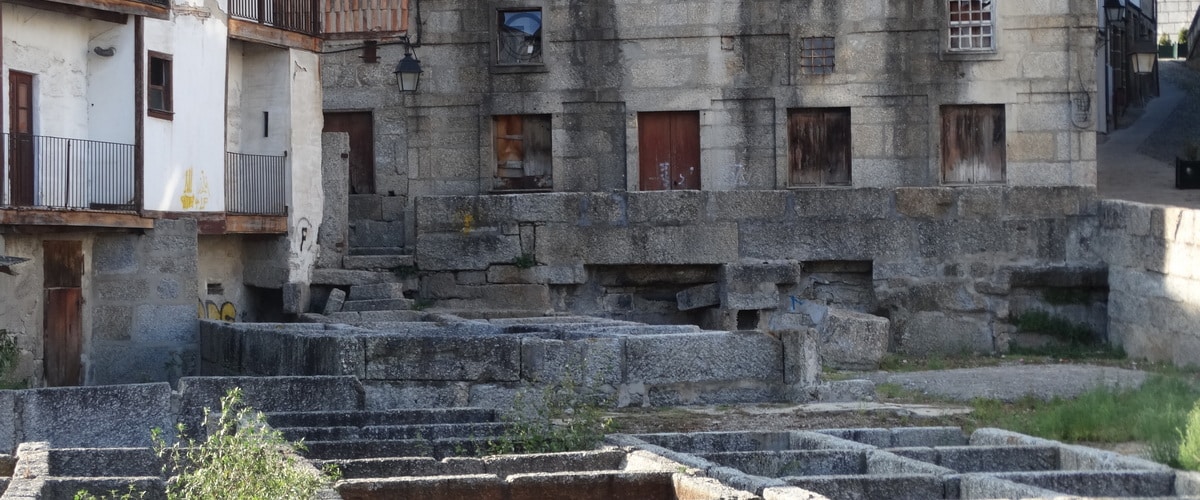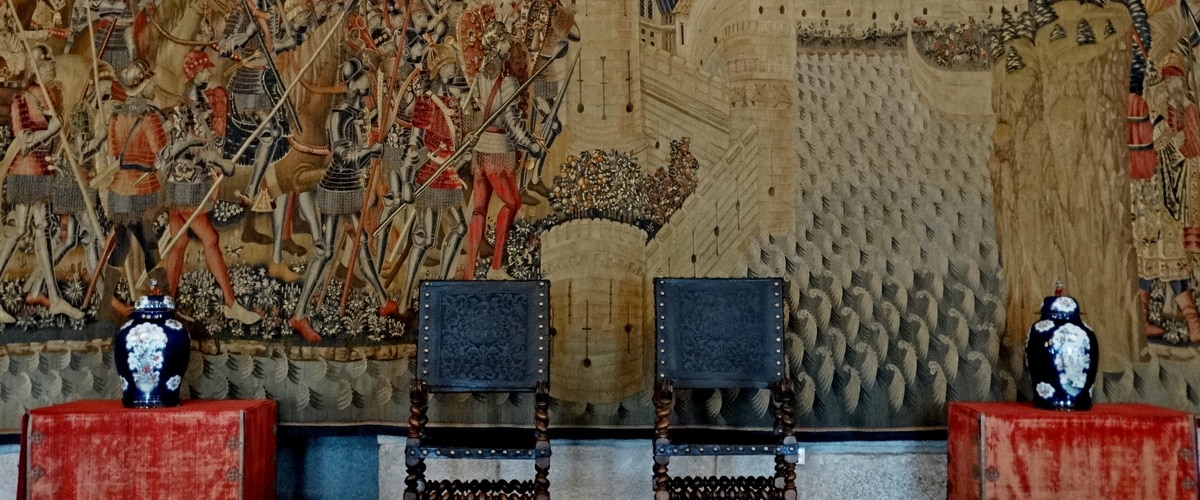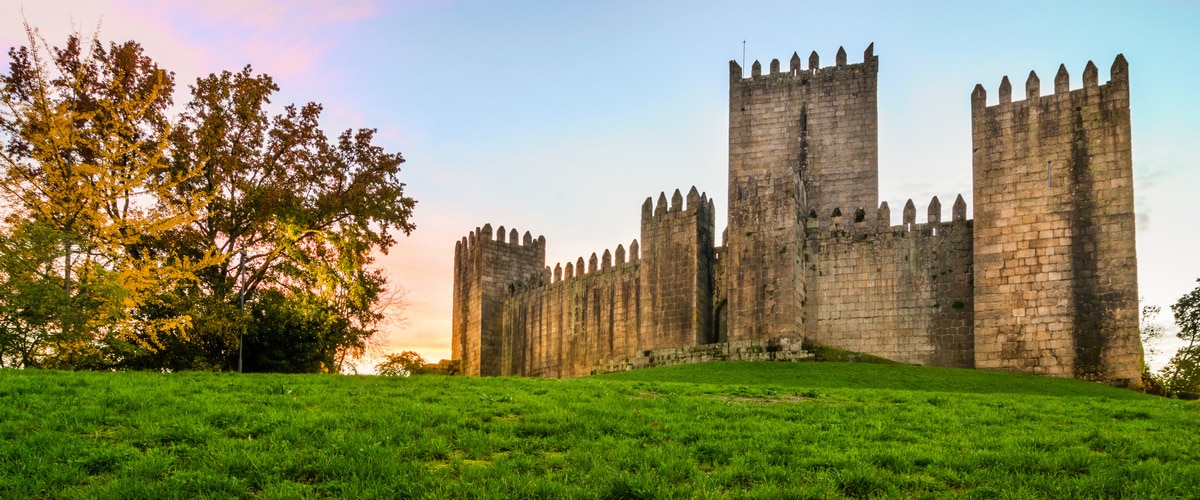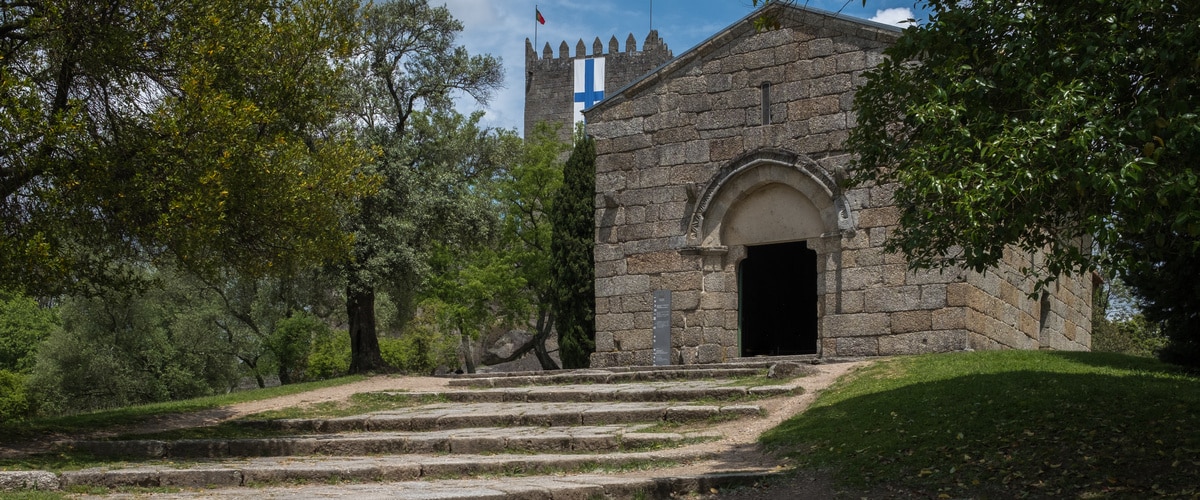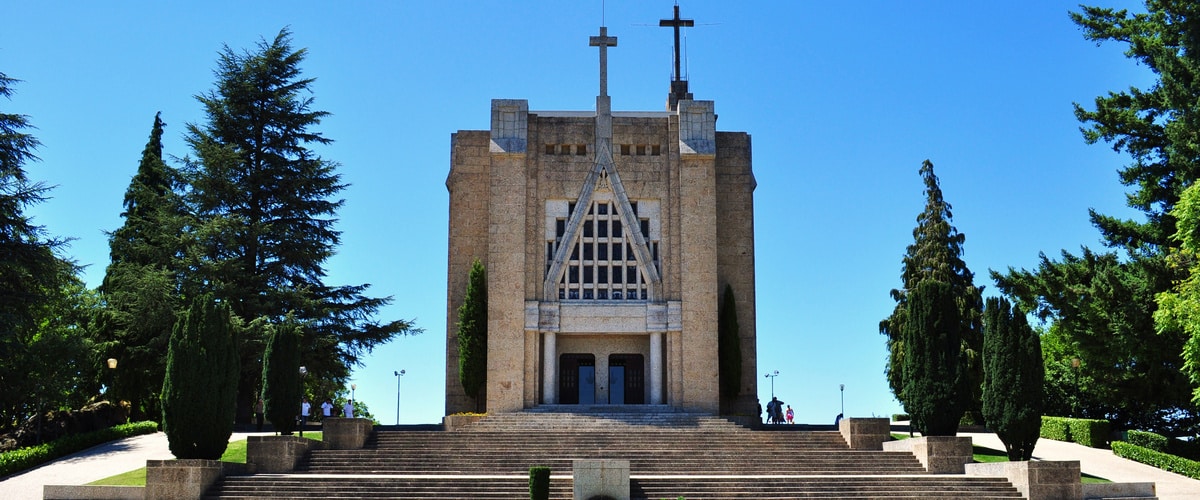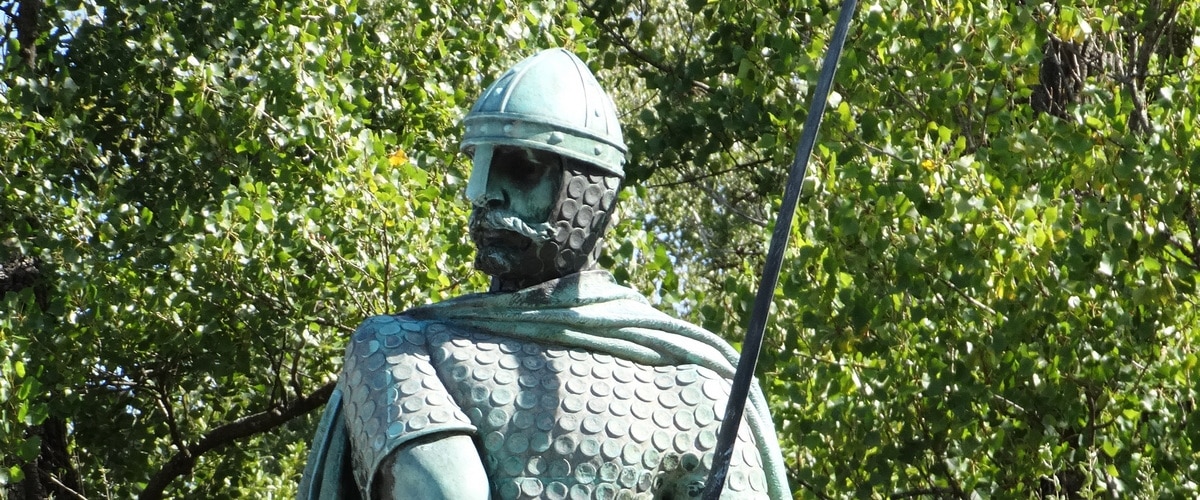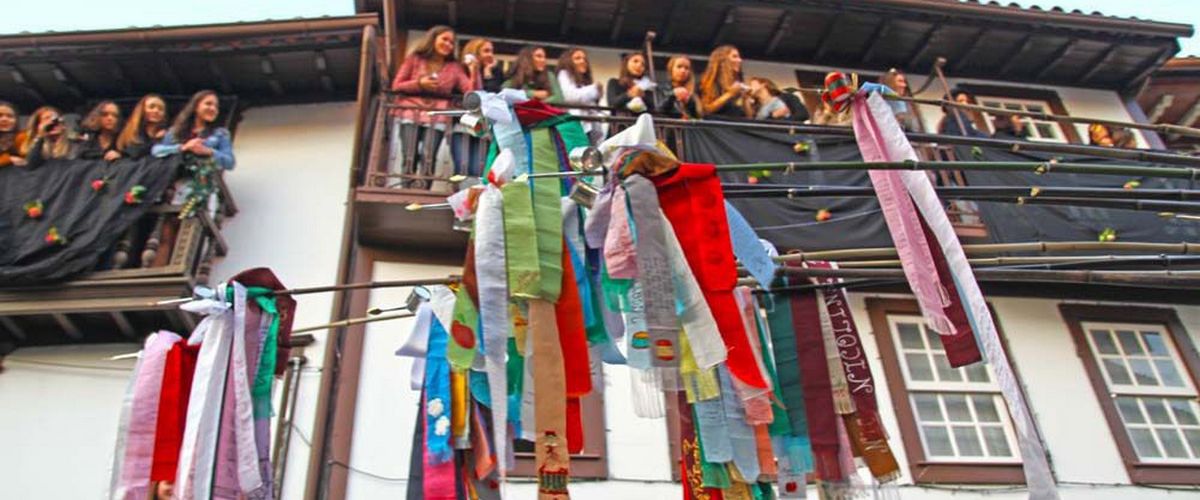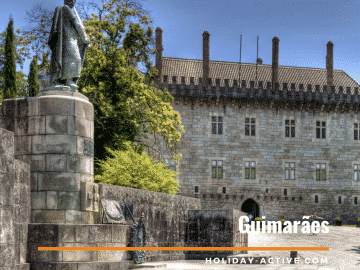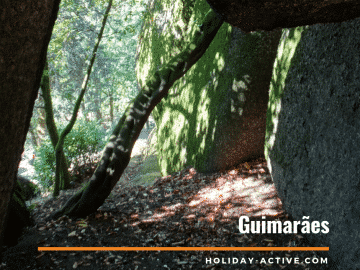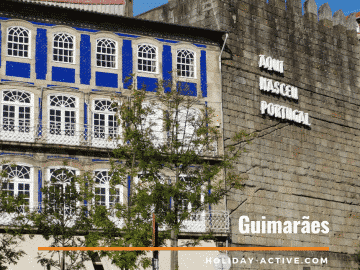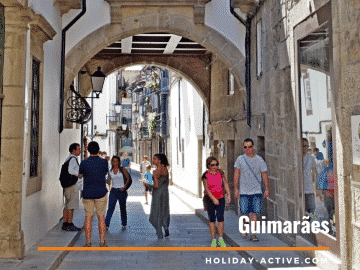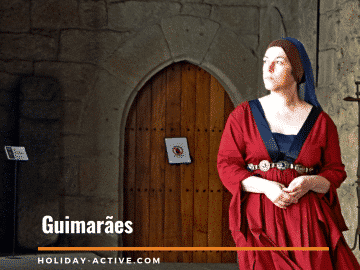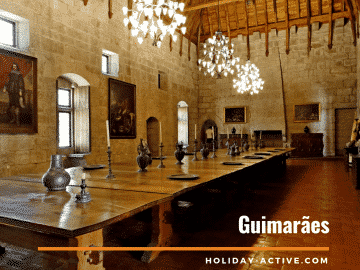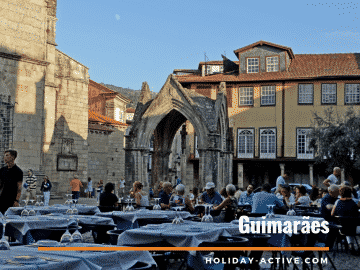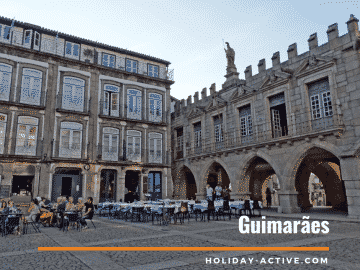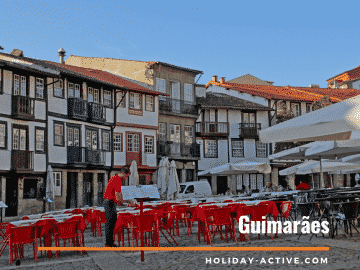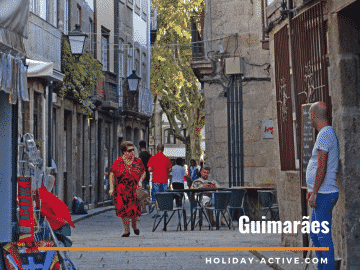Guimarães
Guimarães is considered the birthplace of Portugal.
Guimarães historical centre is classified as World Heritage by UNESCO, and it is a step into the past to walk inside these castle walls and imagine the soldiers that have once walked these granite streets: Castilian, Portuguese and Spanish.
It is impossible not to soak in the past, and dwell on history in such magnificent scenery.
Guimarães can be visited by foot, in a day. We have organised the city tour into three parts: The Historical Center; Monte Largo and Monte da Penha as to better identify what not to miss on your visit to Guimarães.
What to visit in Guimarães
Historic Centre
Largo da Oliveira
Largo da Oliveira (Olive Tree Square) is a surrounded by beautiful well kept picturesque northern houses that got its name from the olive tree planted there to supply olive oil for the church altar lamps. Legend has it that the olive tree eventually dried up and a local merchant placed a cross in its place. Miraculously, the olive tree regrew. Unfortunately, the present olive tree is no longer the original one.
Here you will find a Gothic shrine, built in the reign of D. Afonso IV to commemorate the Battle of Salado, the Igreja de Nossa Senhora de Oliveira and on the northern side of the square a mediaeval building that once housed the town hall and beneath this, a Gothic arcade leads into the Largo de São Tiago
As such, from here you can either make your way to Largo de S Tiago or Largo do Toural
Igreja de Nossa Senhora da Oliveira (Church)
Founded by the Countess Munadona Dias, it has been a place of Marian worship since the 10th century.
Unfortunately little of its original structure remains.
Before the Battle of Aljubarrota, the king D. João I prayed before the image of Santa Maria, there housed. Having won the battle, he then proceeded to honour his vow by rebuilding this church. Work continued until at least 1413, becoming a landmark of Gothic architecture in northern Portugal.
To be found inside this church is the Museu Alberto Sampaio which exhibits, among others, a collection of medieval and renaissance silver pieces and the tunic worn by D João I during the Battle of Aljubarrota
The bell tower, which has marked Manueline features, stands separate from the main body of the church.
Largo de São Tiago and Rua de Santa Maria
Known as Largo de São Tiago (St James Square) for it is believed the apostle James brought the image of the Virgin Mary to this square, in Guimarães, and placed it on the existing pagan temple
Three storeys, 16th-17th century, charismatic houses with wooden balconies brimming with colourful flowers surround this square while cafes and restaurants invite you to sit down and rest for a bit.
It is especially appealing with the fading sun as electrics lamps light up and bring a magical ambience to this square that is alive up to early hours.
From here you follow the narrow Rua de Santa Maria, one of the first streets to be built in Guimarães. Here you will find the Convento de Santa Clara (17th-century), Casa do Arco, with a small emblazoned bridge over the street, Casa dos Peixotos, the Gothic Casa dos Valadares. The “it” street during mediaeval times.
Igreja da Consolação e dos Santos Passos (Church)
Originally a small hermitage built in 1576 and dedicated to Our Lady of Consolation. However, the current church, designed by the architect André Soares Braga, was completed only in 1785.
Later additions, in the mid 19th century, were the bell towers, designed by the architect Pedro Ferreira, the staircase and the balustrade.
Largo do Toural
Nowadays the centre of the city, it was during the 18th century, outside Castle Walls and where the cattle and produce market took place.
Here you will find the Pastelaria Clarinha, a pastry shop with more than 65 years and known for serving the best Tortas de Guimarães. Give it a try.
Guimarães Leather area
The tradition of working leather is ancient in Guimarães going back to the Middle Ages. It has been greatly responsible for the economic projection of Guimarães and encouraged the development of other complementary activities such as the shoe industry.
The hides from the locally slaughtered cattle were cleaned free from fur and fat and put into shallow granite tanks. They would soak in water, trigging the tanning process.
Oak bark, taken from trees that abound in the high mountains of Fafe, offered the tannin necessary to this process, a piece of knowledge passed down from generation to generation. The tanners’ work was hard, dirty and incredibly smelly.
The old “leather town” was the most insalubrious part of Guimarães.
Monte Largo
Paço dos Duques de Bragança
Commission by the first Duke of Bragança. D. Afonso de Barcelos the illegitimate son of D. João I, during the 15th century. It is inspired by the typical French manor houses.
When the residence of the Dukes of Bragança, one of the wealthiest families in Portugal, was later moved to the Palace of Vila Viçosa, in the Alentejo, the building gradually fell into disrepair.
It served as a military barrack, and it was only in 1937 that it was restored to its former glory. Inside, pieces of 17th-century furniture, collections of ancient weapons and a remarkable group of four enormous tapestries depicting in great detail scenes from the arrival of the Portuguese in Arzila, the siege of this same city in North Africa and the capture of Tangiers.
The Castle of Guimarães
On Monte Largo (Broad Hill) stands the Castle of Guimarães.The starting point of Portuguese history, the beginning of the Nation of Portugal.
During the 10th century, the widowed Countess Mumadona Dias, orders the construction of a monastery in her estate Vimaranes (today Guimarães).
Later she surrounded it with stone walls to protect to not only the clergy but the populations from the constant attacks from the Vikings, who arrived by sea from the north of Europe, and the Muslims, who made raids from the territories that they occupied to the south. These were the first stones placed for what was to become the Castle of Guimarães.
During the 12th century, Conde D.Henrique e D.Teresa come to Guimarães, taking over the governorship of the province known as Condado Portucalense from his father-in-law, Alfonso VI of León, ordering another more substantial construction to be built. Here they settled down, and it is believed that it was here that D.Afonso Henriques was born
Igreja de São Miguel do Castelo (Church)
A church of great simplicity built by Conde D.Henrique (Henry of Burgandy) during the 12th century. It was here that his son, D Afonso Henriques, later the first King of Portugal is believed to have been baptised.
Beneath the floorboards, great knights of the nations founding period are buried.
Monte da Penha
Monte da Penha ou Monte de Santa Catarina
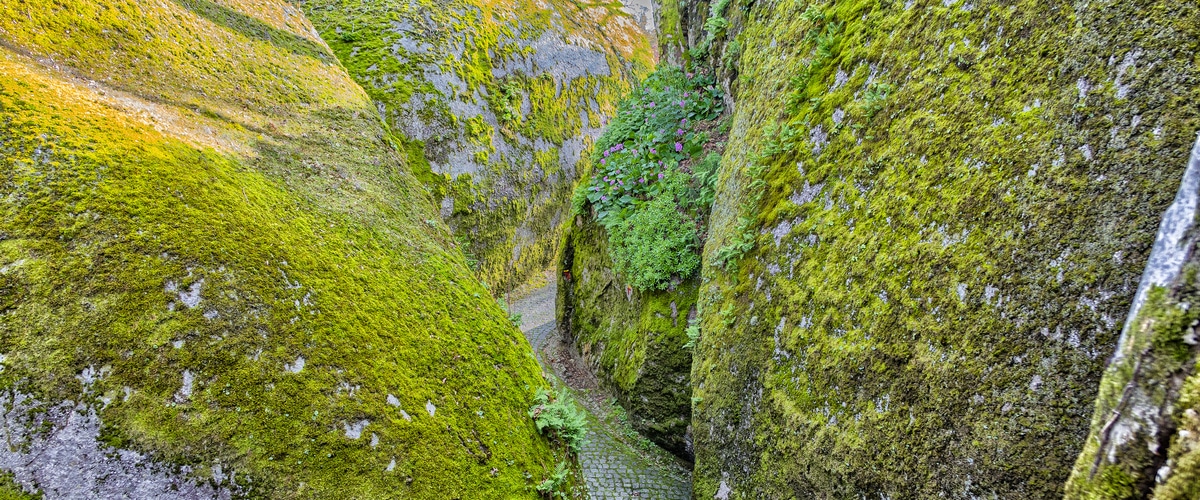
Besides the Sanctuary, there is a campsite, an inn, a mini-golf and horse riding centre, picnic area and a restaurant
To get there, take the cable car, and get one of the best views of Guimarães
Santuário de Nossa Senhora da Penha
Santuário de Nossa Senhora da Penha (Shrine of Our Lady of Penha).
The chapel was commissioned in 1652 and in 1727 was integrated within the Convent of the Immaculate Conception.
The annual pilgrimage is held on the second Sunday in September.
A little bit of Portuguese history
Condado Portucalense and D. Afonso Henriques
D. Alfonso VI, King of Leon, gave to his son-in-law the Conde D. Henrique de Borgonha (Count Henry of Burgundy), the territories that he had to the south of the river Minho, to be administered in his name, thus constituting the Condado Portucalense.
On the death of D. Henrique de Borgonha his wife, D. Teresa, daughter of King D Afonso VI of Leon succeeded him, since their son, Infante D Afonso Henriques, was still an infant.
D Teresa continued the ambition and course of her husband: to achieve the independence of the county. Nevertheless, the influence gained by her noble Galicians and her hostility to the Portuguese noblemen originated in their revolt under the leadership of her son, D. Afonso Henriques. He eventually defeated his Mother in the battle of S. Mamede in 1128, driving her out of the lands she had ruled for more than fifteen years.
D Afonso Henriques continued battling his way south and in 1143, was recognised as King of Portugal.
Egas Moniz
In 1127, when D Afonso Henriques found himself surrounded by King D Afonso VII troops, in the Guimarães Castle, Egas Moniz, D Afonso Henriques tutor, addressed the enemy king and promised that D Afonso Henriques would pay obedience to him. With such promise, D. Afonso VII raises his siege.
But D Afonso Henriques does not yield and continues his war for independence. Egas Moniz, seeing that he had given his word in vain, went to D Afonso VII, accompanied by his family, dressed as penitents, surrendering to the sovereign and ready to receive his punishment for not having fulfilled what he had promised. Admired before such greatness and worship of honour to the word given the king sends him in peace.
Festas Nicolinas (Festivaties)
The Festas Nicolinas begin with the pine tree on November 29 and last for 8 days. Of profane and pagan origin they were completely integrated into the popular culture, and are part of the cities students festivities, with the sound of drums echoing through the city
What to taste
Tortas de Guimarães: made with puff pastry and stuffed with sweet “chila (pumpkin)”, eggs and almonds.
Touchinho do Céu: Original recipe from the Convent of Santa Clara it is the ex-libris of the Vimaranense sweets, being considered one of the best in the country. It is an egg-based cake, almonds and sweet “chila (pumpkin)”, wrapped in flour.
How to get to Guimarães
Guimarães is 55km north-east of Porto which makes it an ideal city day trip from Porto. It is easily accessed by car, train or bus
By car
It’s about 40 minutes to Guimarães from Porto with good roads. Should you need to rent a car, check out our best deals
Train
Porto – Guimarães is connected by a frequent and direct train service and is an easy and comfortable option, more so as the train station in Guimarães is just 1km from the historical centre. You may catch the train either in S. Bento Train Sation or in Campanhã, and it takes little more than an hour to get to your destination.
Bus
There is also a regular bus schedule to Guimarães, including a bus that will take you from the airport directly there.
Whatever your choice, if you have a day or more to spare, do pay it a visit.
Handpicked Tours in Guimarães
You will want to know more about this city that was the birthplace of the nation. The Nobles struggle for power, the wars and intrigues and the strength of a man who conquered a kingdom.
Book a Guimarães tour and get to know the essence of Portugal
We use affiliate links which means we get a small commission if you book through them. This does not in any way affect the end price but helps us keep this site updated. We selected the Top Tours of What to do in Guimarães we believe to be the most relevant and with an insider’s knowledge.
Enjoy Portugal with holiday-active.com and make the most of your holidays in Guimarães
What to do in Guimarães, the birthplace of Portugal
Your perfect accommodation in Guimarães
Where to stay in Guimarães? Our suggestions
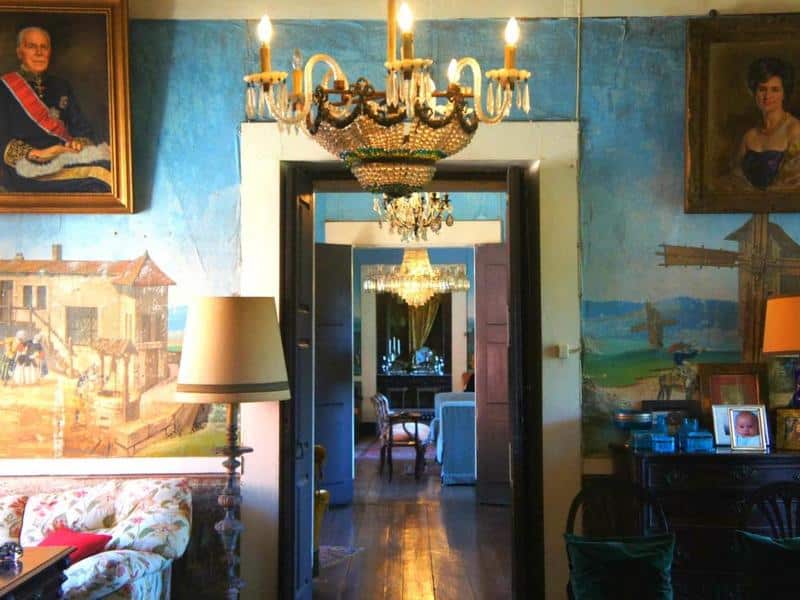
Casa de Sezim
A century-old farmhouse from the 14th century, it has a noble and distinguished elegance, imposing details such as wallpapers dating from the 19th century. Its 8 rooms are spacious, with wooden floors and decorated with period furniture.
Surrounded by vineyards and a lush forest, it offers a swimming pool, tennis court and manicured gardens. The farm is known for its wines and organizes public events such as exhibitions and piano concerts.

Santa Luzia ArtHotel
With bold architecture, it seeks to preserve the old building on which it was built. It has 99 rooms, a spa with a sauna and a Turkish bath, a gym, a restaurant, an outdoor auditorium and a rooftop pool.
Located 500m from the historic centre of Guimarães.
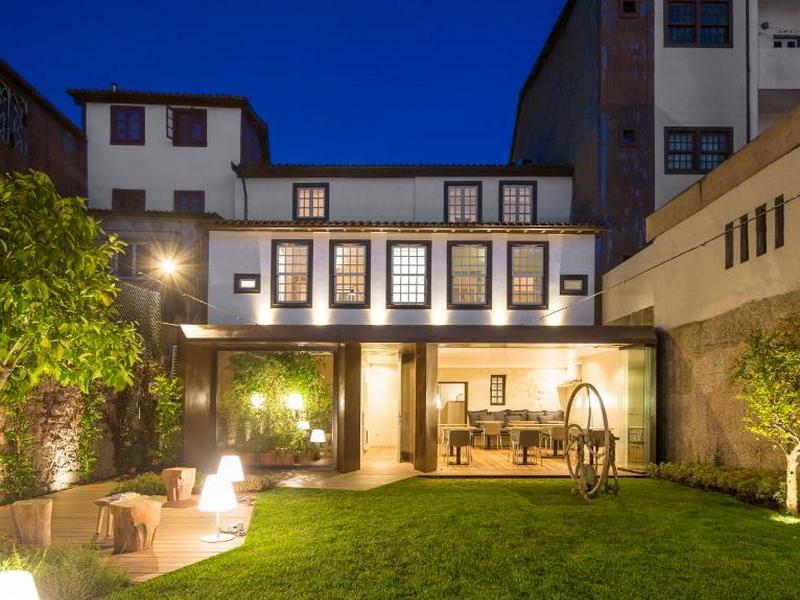
Casa do Juncal
An 18th-century mansion offering suites with comfort and elegance overlooking the garden. Located within the city walls, it allows guests to explore the historic centre easily.
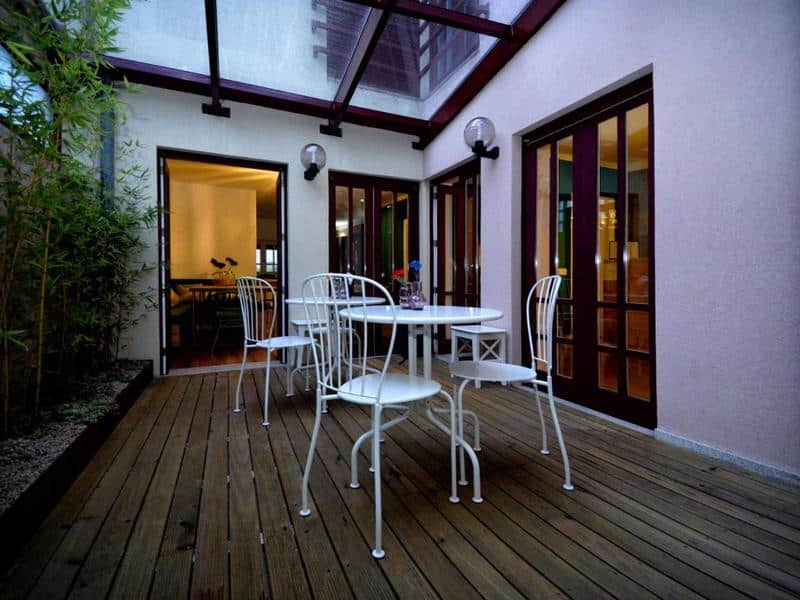
GuimaraesLiving – Hostel & Adventure
It is located in the centre of the city of Guimarães. The dorms include bunk beds, or you may opt for a studio or family room, all with a very cosy decoration. A shared kitchen is available
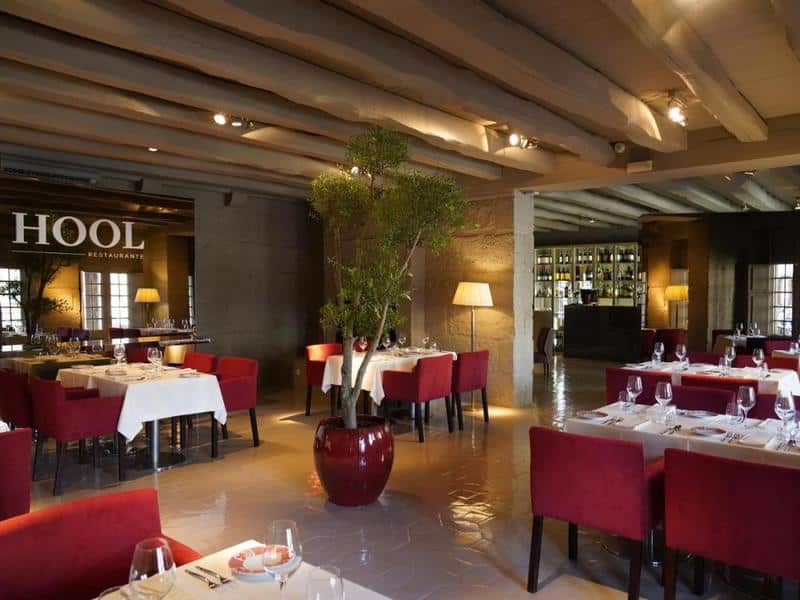
Hotel da Oliveira
A hotel that has maintained its connection to the city’s history, with a touch of modernity. With 20 rooms and suites, some with a terrace overlooking the centenary Largo da Oliveira. Rooms are individually decorated with themes inspired by the historical personalities of Guimarães.
A restaurant with traditional and international dishes and a library complete the offer.

Vila Baixa
In a building with history in a privileged location. Vila Baixa is a cosy and comfortable accommodation with a kitchenette. Ideal for visiting Guimarães on foot.
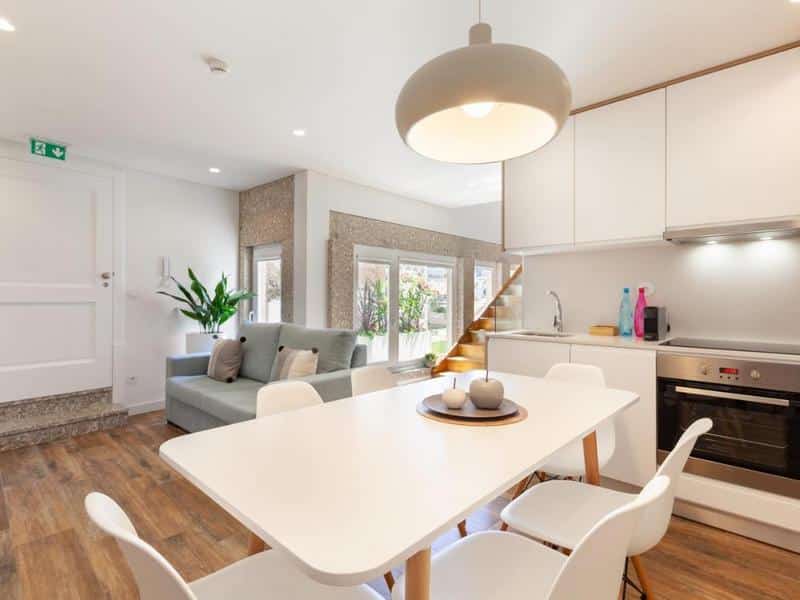
Polery Apartments Center
In the city center next to Largo do Toural providing quick access to everything to see in Guimarães. Polery Apartments Center offers apartments with a fully equipped kitchen and open onto a garden or terrace.
No pets allowed

Vale de S. Torcato Houses and Wine Bar
This guest house offers rooms and suites in the quiet village of S Torcato, 4.3 km from Guimarães Castle. Some of the units include a kitchenette and a terrace. The decoration respects sustainability and combines local crafts and materials with sophistication. It also has a heated swimming pool, gym, a garden with a wide variety of camellias and a mini-golf
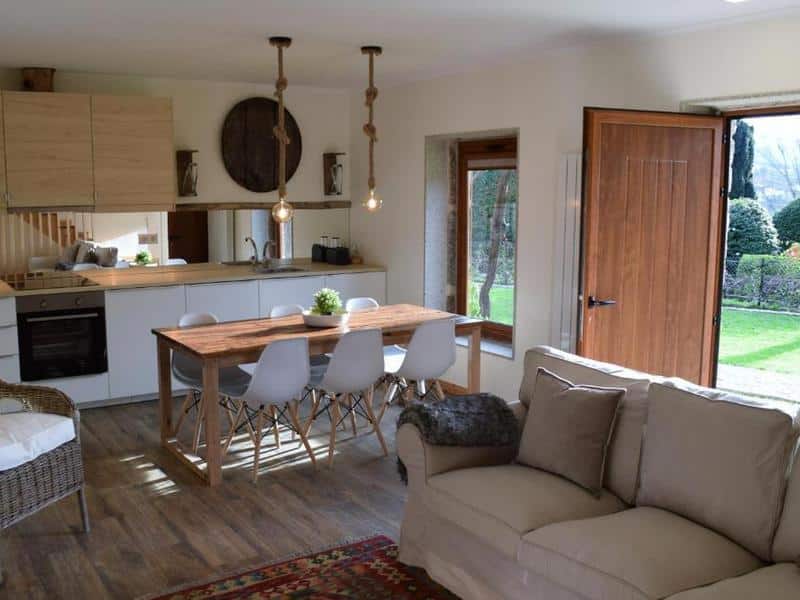
Villa Margaridi
Villa Margaridi brings together the pleasure of being in the countryside while being practically in the city’s centre. Only five minutes from the city centre, just above Guimarães Castle. It offers fully furnished apartments set aside from the main manor, with access to a swimming pool and garden with imposing camellia trees.

 English
English

